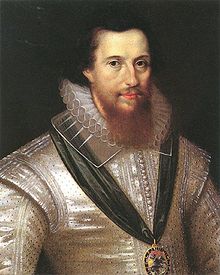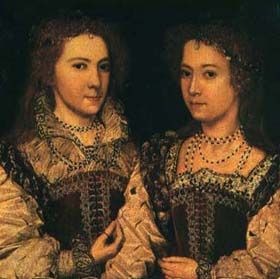Penelope Devereux: Life Story
Chapter 4 : Penelope and Essex (1590 - 1600)
Penelope’s relationship with her brother was always close. During the 1590s, as she spent less time at Leez, and pursued her relationship with Mountjoy, she took on a role as Essex’ chief supporter, friend and hostess. Her sister-in-law, Frances Walsingham, who had previously been married to Sir Philip Sidney, seems to have happily taken a more retired position. Frances was regularly pregnant, but suffered several miscarriages and infant deaths, as well as having to tolerate a husband who was a notorious philanderer.

In 1593, Essex became one of Elizabeth’s Privy Councillors, yet he was not satisfied. He wished to supplant the Cecils in Elizabeth’s favour, and, aided by Penelope, spent much time and money building up an information network (or spy-ring, depending on your point of view) across England, France and Spain. He too, despite the strongly Protestant background from which he and Penelope came, was flirting with the many disaffected Catholics who had been given new courage by the Jesuit mission.
During the 1590s both Essex and Mountjoy were involved in military campaigns. Finally, in 1599, Essex took command of the campaign in Ireland, which proved as disastrous for him, as it had for his father. He disobeyed direct commands from the Queen, and wasted money and men. He returned to England, in contravention of orders, and was questioned by the Privy Council in a five-hour session, that concluded that he had deserted his post, and made a dishonourable truce with O’Neill.
Essex was committed to house arrest at one of his London homes, York House. Whilst he was confined there, he suffered some illness, perhaps a fever caught on campaign, or perhaps stress-induced. Both Penelope and her sister, Dorothy, Countess of Northumberland, received permission to wait upon the Queen to beg for permission for him to move to somewhere with ‘better air’ and to be allowed to see him. Making a show of mourning by dressing in black from head to foot, they went to Richmond. The Queen received them kindly, but she would not budge. Penelope continued to plead, sending letters, presents and jewels to the Queen, which the Queen accepted, without changing her mind.

Eventually, one of Penelope’s letters went too far. Her enthusiasm for her brother’s cause, and her conviction that the Cecils were up to no good, was read as a hint that rebellion was in the air, and she was summoned before the Lord Treasurer, Sir Thomas Sackville, later Earl of Dorset, to explain herself. She hastily followed up with another letter to the Queen, protesting loyalty. Not long after, she was accused of having allowed copies of the earlier, suspect, letter, to be distributed and was summoned again to the Privy Council.Taken ill, either really, or politically, she was excused attendance, and retired to the country. Her distress was probably added to by the dispatch of Mountjoy to Ireland to replace Essex. Penelope was again interrogated about her offending letter, but the Queen, at length, forgave her, whilst complaining that she ‘showed a proud disposition’ and had been very negligent.
At last, it appeared that the Queen would forgive Essex, too and he was released from house arrest in August 1600. But this was not a complete restoration - Elizabeth refused to renew his main source of income, the monopoly on sweet wines, which had been granted in 1589.
Financially ruined, and increasingly paranoid, Essex fortified Essex House, with his wife, Frances, and Penelope in support. After taking several Privy Councillors hostage, Essex, together with his chief supporters, the Earl of Southampton and Penelope’s step-father, Sir Christopher Blount, rode through the streets of London, trying to gain followers to overthrow the Cecils, whom he continued to blame for his disfavour with the Queen. The Londoners were underwhelmed and Essex retreated to his house, sending Penelope and Frances away.
Essex was captured and sent to the Tower and Penelope was placed under house arrest with Sir Henry Sackford. Following his trial (in which Lord Rich was one of the judges) Essex was adjudged guilty. Afterwards, he requested that members of the Council be sent to the Tower to hear the “truth.” This consisted of denouncing both Mountjoy and Penelope whom, he claimed, had pushed him into treason:
‘I must accuse one who is most nearest to me, my sister who did continually urge me on…’
He added that ‘she must be looked to, for she hath a proud spirit.’
This disloyalty must have been an agonising blow to Penelope who herself remained under house arrest, and was questioned by the Privy Council. During her interrogation she pointed out that, far from being the instigator of Essex’ treason, she had:
‘been more like a slave than a sister, which proceeded out of my exceeding love, rather than his authority’
Essex was executed on 25th February 1601, together with Sir Christopher Blount, Penelope’s step-father. Eventually released, Penelope herself was sent home to her husband. Meanwhile, Mountjoy had been running the most successful campaign in Ireland of the whole era, whilst secretly corresponding with King James.
Lady Penelope Devereux
Family Tree






